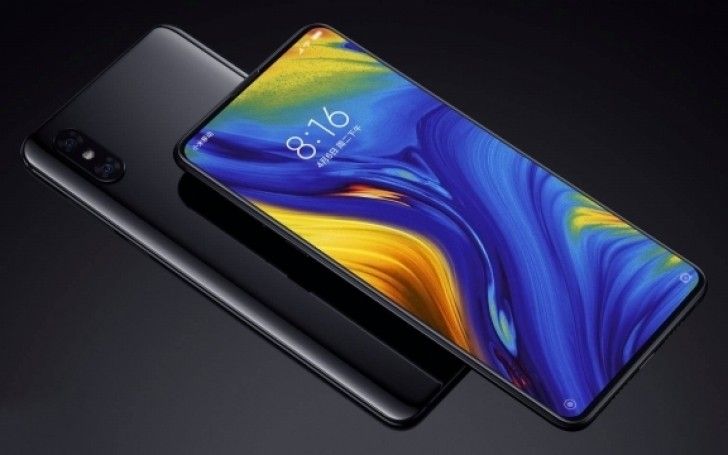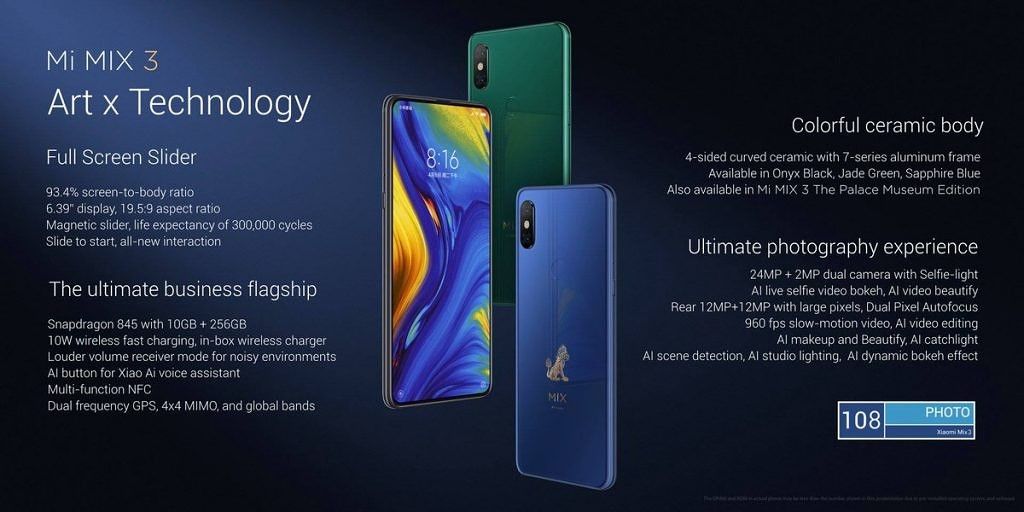We are closer than ever to realize the dream of bezel-less smartphones. To start off, 18:9 displays with smaller bezels arrived in 2017. Then, we moved to the land of notched displays with aspect ratios higher than 18:9. After that, we are seeing waterdrop notches becoming a new trend in the market. Earlier this year, the Vivo NEX and the OPPO Find X broke away from the market by opting to do away with a notch entirely, in favor of a motorized pop-up camera and a motorized bezel respectively. What we hadn't seen yet is a phone with a manual slider, the bezel of which could be manually slid up just like the old days. The wait ends here, as the Xiaomi Mi Mix 3 has finally been made official.
The Xiaomi Mi Mix 3 brings a series of firsts to Xiaomi. It's the first Xiaomi phone to have a manual slider. It's the first Xiaomi phone to feature up to 10GB of RAM. It's the first Xiaomi phone that will have an upcoming 5G variant early next year. It's the first Xiaomi phone to feature 960fps slow motion video recording. There is a lot to get into here, so let's start with listing the full specifications of the phone.
Xiaomi Mi Mix 3 - Specifications at a glance
|
Specifications |
Xiaomi Mi Mix 3 |
|---|---|
|
Software |
MIUI 10 on top of Android 9 Pie |
|
SoC |
|
|
RAM and storage |
6GB/8GB of RAM with 128GB/256GB of storage; Palace Museum variant: 10GB of RAM with 256GB of storage |
|
Battery |
3,200mAh; 10W wireless charging, Quick Charge 4.0+ |
|
Display |
|
|
Bands |
|
|
Audio |
|
|
Connectivity |
|
|
Ports |
|
|
Rear camera |
|
|
Front-facing camera |
|
Design
Instead of going with a motorized pop-up camera or a motorized front bezel, the Xiaomi Mi Mix 3 has a magnetic manual slider. According to Xiaomi, the slider can also take the place of a customizable shortcut action for many tasks. Users can use it to take a self-portrait, open the app drawer, make a call, and do other tasks by sliding up the slider. A sound will be played every time the user slides up the bezel, and it can be customized according to preference. Xiaomi says that the slider is expected to last up to 300,000 cycles. Antenna space has been reduced by up to 72% thanks to a new antenna design.
The Xiaomi Mi Mix 3 does not have an in-display fingerprint sensor, as it opts to go with a back-mounted conventional fingerprint sensor. Unlike the OPPO Find X, it does not have 3D facial recognition.
The front is where the Mi Mix 3 makes a break away from the traditional Mi Mix series design. The first-generation Xiaomi Mi Mix was a pioneer in many ways as it foreshadowed the rise of taller aspect ratio displays. However, the Mi Mix series placed the front camera on the bottom bezel of the front, which was awkward. Xiaomi then adopted the notch with the Xiaomi Mi 8 and the Xiaomi POCO F1, but with the Mi Mix 3, the company returns to its roots by offering another notch-less phone. This time, the front-facing camera is placed in a better position on the hidden top bezel, and users have to slide up the bezel to use it.
As usual, the Mi Mix 3 incorporates Elliptic Labs' ultrasonic technology to replace the traditional IR proximity sensor. This time, the phone is said to use Elliptic Labs' Inner Beauty III module in their AI Virtual Smart Sensor platform. The module "fuses ultrasound sensor data with standard smartphone data to enhance gesture recognition and enable presence detection for phones."
Display
The Xiaomi Mi Mix 3 is the first Mi Mix series phone to switch to an AMOLED display. It has a 6.4-inch Full HD+ (2340x1080) AMOLED display with a 19.5:9 aspect ratio, 403 PPI, and a high 93.4% screen-to-body ratio with a near bezel-less design. The display size is the same as the OnePlus 6T, but there is no notch here.
Cameras
In another first, the Mi Mix 3 is the first Mi Mix series device to have dual front cameras and dual rear cameras. The dual rear camera setup has similar specifications as the older Xiaomi Mi Mix 2S and the Mi 8, but it now comes with Night Mode. At the event, Xiaomi even compared the phone's Night Mode with the excellent Night Mode found in the Huawei P20 Pro's camera. The rear cameras have received a DxOMark overall rating of 103, placing it only below the Huawei P20 Pro and the Apple iPhone XS Max, with a 107 photo rating and a video rating of 93.
Predictably, the camera features AI scene recognition. It also has 960fps slow motion video recording, similar to the Huawei P20 Pro. This is likely achieved with the use of frame interpolation from 240fps to 960fps, as the Sony IMX363 sensor doesn't have a DRAM die unlike the Samsung Galaxy S9's camera, which is capable of recording true 960fps videos.
The 24MP primary front-facing camera uses 4-in-1 pixel binning to simulate 1.8μm pixels, which effectively reduces the resolution to 6MP in such scenarios. The secondary camera is a 2MP depth sensor.
Connectivity
There is no 3.5mm headphone jack on the Xiaomi Mi Mix 3, and Xiaomi's decision to drop the port continues to disappoint. There is also no microSD card slot for expandable storage. Other connectivity aspects are covered with NFC, dual 4G VoLTE, and more.
The Mi Mix 3 is powered by a 3,200mAh battery with fast charging. It also supports 10W wireless charging with the Qi standard.
5G variant
Xiaomi also announced that a 5G NR variant of the Mi Mix 3 will launch in Q1 2019. It will be launching in Europe, but availability in other markets wasn't revealed yet.
Pricing and availability
The Xiaomi Mi Mix 3 will be available in three colors: Onyx Black, Sapphire Blue, and Jade Green. The 6GB RAM/128GB storage variant costs CNY 3,299 ($474), while the 8GB RAM/128GB storage variant costs CNY 3,599 ($515). The 8GB RAM/256GB storage variant costs CNY 3,999 ($575). Xiaomi will bundle a 10W wireless charger and a case in the package.
The 10GB RAM variant will go on sale at the end of November, and it has 256GB storage. It will cost CNY 4,999 ($720). It comes in a different Blue color.
Pre-orders for the Xiaomi Mi Mix 3 are now open for the regular variants, and availability will start from November 1. Xiaomi revealed that the Mi Mix 3 would be available internationally, including in India. This is a significant announcement considering that the Mi Mix 2S was never launched in India.
What are your opinions regarding the Xiaomi Mi Mix 3? Do you think manual sliders are the way to go forward in order to drop the notch? Let us know your thoughts in the comments below!
This article was updated at 11:31AM on October 27th, 2018, to correct the software version. The device is running MIUI 10 based on Android 9 Pie, not Android 8.1 Oreo.


